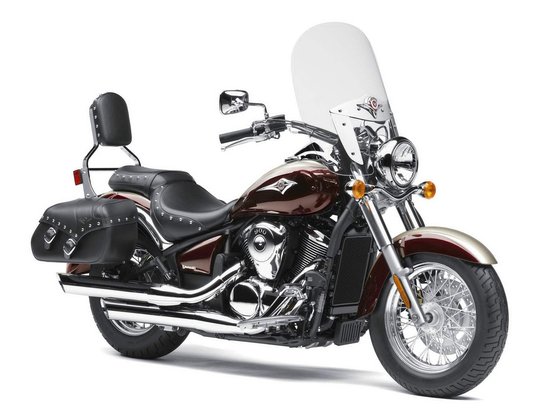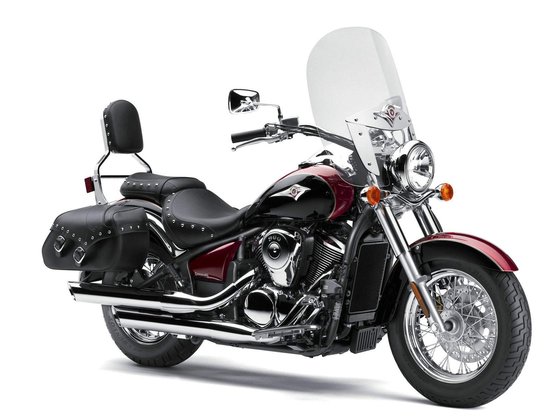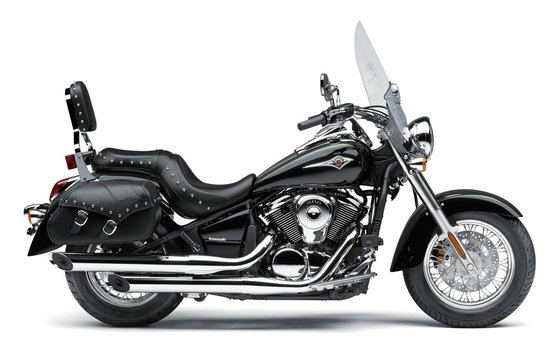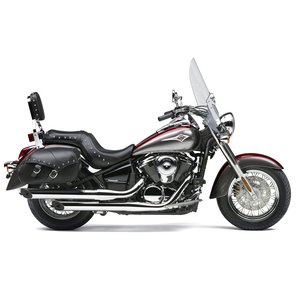Kawasaki VN 900 Vulcan Classic LT (2013–2020): A Touring Cruiser That Balances Style and Substance

Introduction
The Kawasaki Vulcan 900 Classic LT occupies a unique space in the cruiser world—a midsize motorcycle that feels anything but middle-of-the-road. Produced from 2013 to 2020, this model generation carved out a reputation as a touring-ready machine that doesn’t force riders to compromise between agility, comfort, and classic cruiser swagger. With its factory-installed windscreen, leather saddlebags, and passenger backrest, the Vulcan 900 Classic LT isn’t just a weekend toy; it’s a genuine mile-muncher designed for riders who want to chase horizons without breaking the bank (or their backs).
After spending a day in the saddle of a well-maintained 2018 model, it’s clear why this bike remains a favorite in the pre-owned market. Let’s dive into what makes this Vulcan generation stand out—and where it fits into the broader cruiser ecosystem.
Design: Classic Cruiser Aesthetics, Modern Touring Practicality

At first glance, the Vulcan 900 Classic LT screams “traditional cruiser” with its teardrop fuel tank, sweeping fenders, and chrome accents. But Kawasaki’s designers injected thoughtful touring DNA into every curve. The 26.8-inch (680 mm) seat height isn’t just a spec sheet flex—it’s a game-changer for shorter riders or anyone tired of tip-toeing at stoplights. The low-slung frame integrates seamlessly with the 5.3-gallon (20-liter) fuel tank, creating a profile that’s both muscular and approachable.
Two-tone paint schemes (like Metallic Moondust Grey/Ebony or Candy Cardinal Red/Metallic Graystone) elevate the bike’s visual drama, while practical touches abound:
- Leather saddlebags: Reinforced cowhide with quick-release buckles and Vulcan-branded studs. These aren’t mere props—they’re weather-resistant and large enough for weekend gear.
- Adjustable windscreen: A 0.2-inch (5 mm) thick acrylic shield that reduces buffeting without sacrificing the open-air cruiser feel.
- Passenger backrest: A tombstone-shaped pad studded to match the rider’s seat, ensuring your co-pilot stays put during long hauls.
The spoke wheels and 180/70-15 rear tire (the widest in its class during its release) add a burly stance, but it’s the details—like the LED-illuminated speedometer and chrome exhaust tips—that make this Vulcan feel premium.
Engine and Performance: Torque Over Top Speed

Powering the Vulcan 900 Classic LT is a 903cc liquid-cooled V-twin tuned for relaxed cruising rather than drag-strip heroics. With 50 hp (37 kW) at 5,700 RPM and 58 lb-ft (78 Nm) of torque peaking at 3,700 RPM, this engine prioritizes low-end grunt. Throttle response is crisp thanks to dual 34mm Keihin throttle bodies, and the fuel injection system eliminates the cold-start drama of older carbureted rivals.
Key highlights:
- Belt drive: The Kevlar-reinforced belt is a standout feature, offering silent operation and minimal maintenance compared to chains. It’s a godsend for riders who hate lubing chains mid-tour.
- Liquid cooling: Combined with finned cylinders, this keeps temps in check during summer traffic jams. The fan kicks in discreetly, and the digital temp gauge (a rarity in this segment) provides peace of mind.
- 5-speed transmission: The gearbox is smooth, though the absence of a sixth gear is felt at highway speeds. At 70 mph (113 km/h), the engine hums at ~3,500 RPM—relaxed but not silent.
The single-pin crankshaft delivers that signature V-twin lope, but Kawasaki’s gear-driven balancer keeps vibrations in check. You’ll feel a gentle pulse at idle, but nothing that numbs your hands on a 200-mile day.
Rider Comfort and Ergonomics: Built for the Long Haul

Kawasaki nailed the ergonomics here. The pullback handlebars and forward floorboards create a natural, upright riding position. Unlike some cruisers that force a slouched posture, the Vulcan 900 LT lets you sit in the bike rather than on it. The seat, while firm at first break-in, molds to your shape over time. Passengers get a generous pad and backrest—a rare combo in midsize cruisers.
The adjustable windscreen deserves special praise. At 5'9" (175 cm), I found the mid-height setting deflected airflow over my helmet, reducing fatigue. Taller riders might max out the adjustment, but even then, turbulence stays manageable.
On-Road Manners: Stability Meets Surprising Agility

With a 64.8-inch (1,645 mm) wheelbase and 32-degree rake, the Vulcan 900 LT leans toward straight-line stability. Yet, the narrow chassis and low CG make it shockingly nimble. U-turns on two-lane roads require minimal effort, and the 657-lb (298 kg) wet weight feels manageable once moving.
The suspension setup—41mm forks with 5.9 inches (150 mm) of travel and a Uni-Trak rear shock—is tuned for comfort. It soaks up potholes admirably, though aggressive cornering exposes its plush limits. Braking is adequate, with a single 300mm front disc and 270mm rear rotor offering predictable (if not sporty) stopping power.
The 180mm rear tire provides ample grip, and the tubed design simplifies roadside repairs—a smart choice for a touring-oriented bike.
Competition: How the Vulcan 900 LT Stacks Up

The midsize cruiser segment is fiercely competitive. Here’s how the Vulcan 900 LT compares to its rivals:
Honda Shadow Phantom
- Pros: Lighter (549 lbs/249 kg), lower seat, chain drive for easier customization.
- Cons: Smaller 745cc engine, no factory windscreen or bags.
- Verdict: The Shadow is a better city slicker, but the Vulcan dominates for touring.
Suzuki Boulevard C50T
- Pros: Shaft drive, 805cc engine with slightly more power (52 hp).
- Cons: Heavier (619 lbs/281 kg), bulkier feel at low speeds.
- Verdict: A close match, but the Vulcan’s belt drive and stock luggage give it an edge.
Yamaha Bolt
- Pros: Modern styling, 942cc air-cooled engine, lighter weight.
- Cons: No factory touring options, cramped for passengers.
- Verdict: The Bolt appeals to urban riders; the Vulcan caters to road-trippers.
Maintenance: Keeping Your Vulcan 900 LT Road-Ready

The Vulcan 900 LT is notoriously low-maintenance, but a few areas demand attention:
1. Belt Drive: Inspect for cracks/debris every 6,000 miles (9,656 km). MOTOPARTS.store offers aftermarket Kevlar belts for enhanced durability.
2. Coolant: Replace every 2 years or 16,000 miles (25,750 km). Our store stocks OEM-compatible coolant kits.
3. Brake Pads: The single front disc works hard when loaded. Upgrade to sintered pads for improved bite.
4. Tires: The stock tubes last ~8,000 miles (12,875 km). Consider switching to tubeless radials for fewer punctures.
5. Air Filter: A high-flow filter (available at MOTOPARTS.store) can sharpen throttle response.
Pro tip: The Vulcan’s ECU benefits from occasional throttle position sensor resets—a 10-minute DIY job with our step-by-step guides.
Final Thoughts

The Kawasaki Vulcan 900 Classic LT isn’t the fastest, flashiest, or most high-tech cruiser on the road. What it is, however, is a remarkably coherent package that balances touring practicality with cruiser charm. For riders seeking a dependable two-up machine that won’t vanish into a sea of Harley clones, this Vulcan generation remains a compelling choice.
Whether you’re retrofitting a used model with fresh accessories or prepping for a cross-country trek, MOTOPARTS.store has the upgrades and OEM parts to keep your Vulcan running smoothly. From windscreen risers to premium saddlebag liners, we’ve got your back—because every great ride deserves a great foundation.
Safe travels, and keep the rubber side down.
Specifications sheet
| Engine | |
|---|---|
| Stroke: | Four-stroke |
| Max power: | 37 kW | 50.0 hp |
| Max torque: | 78 Nm |
| Fuel system: | Fuel Injection (DFI® dual 34mm Keihin throttle bodies) |
| Max power @: | 5700 rpm |
| Displacement: | 903 ccm |
| Max torque @: | 3700 rpm |
| Configuration: | V |
| Cooling system: | Liquid and air |
| Compression ratio: | 9.5:1 |
| Number of cylinders: | 2 |
| Valves per cylinder: | 4 |
| Dimensions | |
|---|---|
| Wheelbase: | 1645 mm (64.8 in) |
| Wet weight: | 298 |
| Seat height: | 680 mm (26.8 in) |
| Overall width: | 1005 mm (39.6 in) |
| Overall height: | 1480 mm (58.3 in) |
| Overall length: | 2465 mm (97.1 in) |
| Ground clearance: | 135 mm (5.3 in) |
| Fuel tank capacity: | 20 L (5.3 US gal) |
| Drivetrain | |
|---|---|
| Final drive: | belt |
| Gear ratios: | {'1st': '2.786 (39/14)', '2nd': '1.889 (34/18)', '3rd': '1.360 (34/25)', '4th': '1.107 (31/28)', '5th': '0.963 (26/27)'} |
| Transmission: | 5-speed manual, wet multi-disc clutch |
| Primary reduction ratio: | 2.184 (83/38) |
| Maintenance | |
|---|---|
| Rear tire: | 180/70-15 |
| Engine oil: | 10W40 |
| Front tire: | 130/90-16 |
| Brake fluid: | DOT 4 |
| Spark plugs: | NGK CR8E |
| Spark plug gap: | 0.8 |
| Coolant capacity: | 1.9 |
| Engine oil capacity: | 2.7 |
| Engine oil change interval: | Every 5000km or 2 years |
| Valve clearance (intake, cold): | 0.10–0.20 mm |
| Valve clearance check interval: | 24,000 km / 15,000 mi |
| Valve clearance (exhaust, cold): | 0.20–0.30 mm |
| Recommended tire pressure (rear): | 2.5 bar (36 psi) solo / 2.8 bar (41 psi) with passenger |
| Recommended tire pressure (front): | 2.25 bar (33 psi) |
| Additional Features | |
|---|---|
| Warranty: | 24 months (extendable up to 6 years with KPP) |
| Color options: | Two-tone combinations (varies by year) |
| Special notes: | Largest-in-class 180mm rear tire, Kevlar-reinforced belt drive |
| Standard equipment: | Adjustable windscreen, leather saddlebags, passenger backrest |
| Chassis and Suspension | |
|---|---|
| Rake: | 32° |
| Frame: | Double-cradle high-tensile steel |
| Trail: | 160 mm (6.3 in) |
| Rear brakes: | Single 270mm disc with 2-piston caliper |
| Front brakes: | Single 300mm disc with 2-piston caliper |
| Rear suspension: | Uni-Trak monoshock, 7-way adjustable preload (103 mm travel) |
| Front suspension: | 41mm telescopic fork, 7-way preload adjustable (150 mm travel) |



















